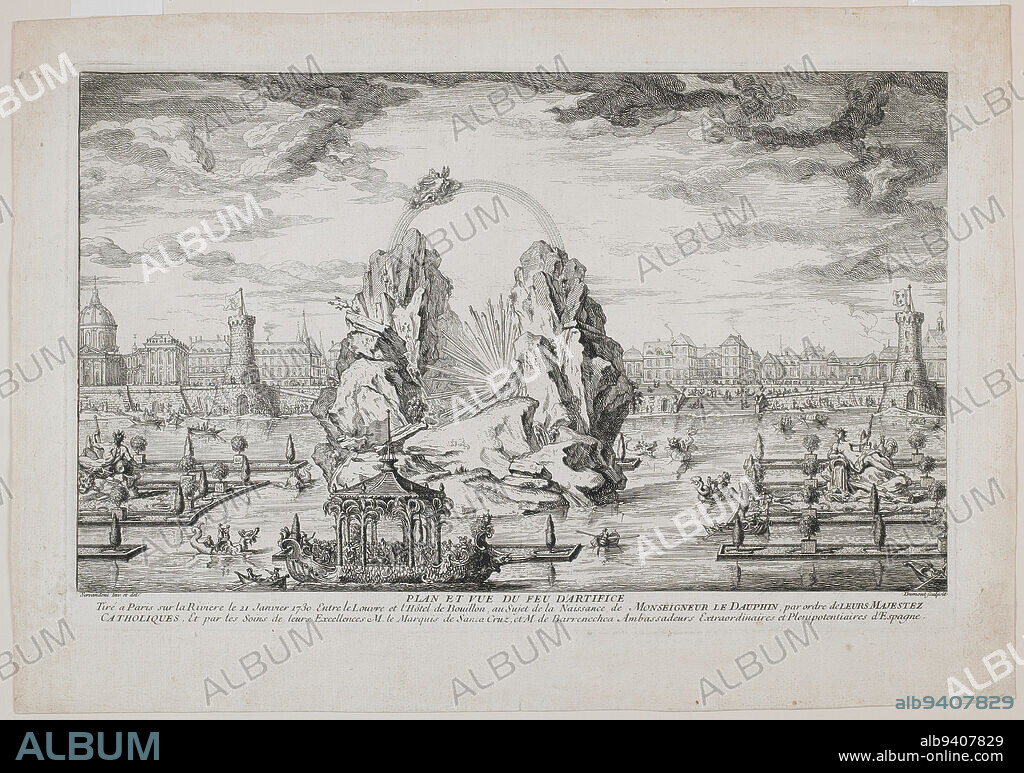alb9407829
Fireworks Dislay in Paris for the Birth of the Dauphin on January 21, 1730, 1730, Jacques Dumont le Romain; Artist: after Giovanni Niccolo Servandoni, French, 1701 - 1781, 12 1/4 x 19 1/4 in. (31.12 x 48.9 cm) (plate)15 1/16 x 21 5/8 in. (38.26 x 54.93 cm) (sheet)23 3/4 x 29 3/4 x 1 1/8 in. (60.33 x 75.57 x 2.86 cm) (outer frame), Etching, France, 18th century, With French governance relying on dynastic succession, the birth of the Dauphin-the male heir to the throne-was cause for celebration. Louis XV's queen, Marie Leszczinska, had given birth to three daughters before having a son on September 4, 1729. In the months that followed, fêtes and fireworks were staged from Paris to Rome. This nautical spectacle was the work of the accomplished architect and stage designer Giovanni Servandoni, who created two fantastical mountains in the middle of the River Seine in Paris, across from the Palais du Louvre, from which to launch fireworks. The fashion for chinoiserie decoration in France is evident in the large pagoda-shaped boat filled with musicians that embarks from the banks of the river, and in the smaller dragon-shaped punts that circle the mountains.

|
Add to another lightbox |
|
Add to another lightbox |



Buy this image.
Select the use:

Caption:
Fireworks Dislay in Paris for the Birth of the Dauphin on January 21, 1730, 1730, Jacques Dumont le Romain; Artist: after Giovanni Niccolo Servandoni, French, 1701 - 1781, 12 1/4 x 19 1/4 in. (31.12 x 48.9 cm) (plate)15 1/16 x 21 5/8 in. (38.26 x 54.93 cm) (sheet)23 3/4 x 29 3/4 x 1 1/8 in. (60.33 x 75.57 x 2.86 cm) (outer frame), Etching, France, 18th century, With French governance relying on dynastic succession, the birth of the Dauphin-the male heir to the throne-was cause for celebration. Louis XV's queen, Marie Leszczinska, had given birth to three daughters before having a son on September 4, 1729. In the months that followed, fêtes and fireworks were staged from Paris to Rome. This nautical spectacle was the work of the accomplished architect and stage designer Giovanni Servandoni, who created two fantastical mountains in the middle of the River Seine in Paris, across from the Palais du Louvre, from which to launch fireworks. The fashion for chinoiserie decoration in France is evident in the large pagoda-shaped boat filled with musicians that embarks from the banks of the river, and in the smaller dragon-shaped punts that circle the mountains.
Personalities:
Credit:
Album / quintlox
Releases:
Model: No - Property: No
Rights questions?
Rights questions?
Image size:
5010 x 3522 px | 50.5 MB
Print size:
42.4 x 29.8 cm | 16.7 x 11.7 in (300 dpi)
Keywords:
1701-1781 • 1729 • 1730 • 18TH CENTURY • 18TH CENTURY, THE • 18TH CENTURY. • 18TH • ACCOMPLISHED ARCHITECT • ACROSS • ARTIST • ARTISTE • BANKS • BIRTH • CELEBRATION • CHILDBIRTH • CHINOISERIE DECORATION • CIRCLE • CIRCULATE • CREATED TWO FANTASTICAL MOUNTAINS • DAUPHIN • DAUPHIN-MALE HEIR • DISH • DYNASTIC SUCCESSION • EMBARKS • ETCHING • EVIDENT • FASHION • FETES • FIREWORK • FIREWORKS DISLAY • FIREWORKS • FLUVIAL • FOLLOWED • FRANCE • FRANCE. • FRENCH GOVERNANCE RELYING • FRENCH • GIOVANNI NICCOLO SERVANDONI • GIVEN BIRTH • HAVING • JACQUES DUMONT LE ROMAIN • JANUARY 21 • LA FRANCE • LABOUR • LARGE PAGODA-SHAPED BOAT FILLED • LAUNCH FIREWORKS • LOUIS XV'S QUEEN • MARIE LESZCZINSKA • MATERNITY • MIDDLE • MODA • MONTHS • MOTHERHOOD • MOUNTAIN RANGE • MOUNTAINS • MUSICIAN • MUSICIANS • NAUTICAL SPECTACLE • OUTER FRAME • PALAIS DU LOUVRE • PARIS • PLATE • RANGE • RIVER SEINE • RIVER • ROME • SEPTEMBER 4 • SHEET • SIERRA • SMALLER DRAGON-SHAPED PUNTS • SON • STAGE DESIGNER GIOVANNI SERVANDONI • STAGED • STREAM • THREE DAUGHTERS • THRONE-CAUSE • WORK • XVIII CENTURY
 Pinterest
Pinterest Twitter
Twitter Facebook
Facebook Copy link
Copy link Email
Email
